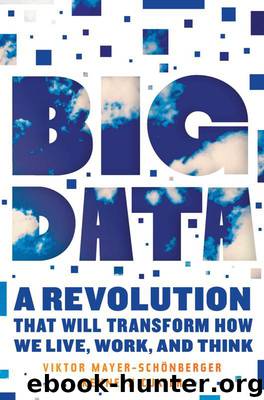Big Data by Viktor Mayer-Schonberger & Kenneth Cukier

Author:Viktor Mayer-Schonberger & Kenneth Cukier
Language: eng
Format: mobi, epub
Tags: Industries, Technology & Engineering, Information Management, General, Management Science, Computer Industry, Business & Economics
ISBN: 9780544002692
Publisher: Houghton Mifflin Harcourt
Published: 2013-03-05T05:00:00+00:00
The big-data value chain
The primary substance of big data is the information itself. So it makes sense to look first at the data holders. They may not have done the original collection, but they control access to information and use it themselves or license it to others who extract its value. For instance, ITA Software, a large airline reservation network (after Amadeus, Travelport, and Sabre), provided data to Farecast for its airfare predictions, but did not do the analysis itself. Why not? ITA perceived its business as using the data for the purpose for which it was designed—selling airline tickets—not for ancillary uses. As such, its core competencies were different. Moreover, it would have had to work around Etzioni’s patent.
The company also chose not to exploit the data because of where it sat on the information value chain. “ITA shied away from projects that involved making commercial use of data too closely related to airline revenue,” recalls Carl de Marcken, a co-founder of ITA Software and its former chief technology officer. “ITA had special access to such data, required to provide ITA’s service, and couldn’t afford to jeopardize that.” Instead, it delicately stayed an arm’s length away by licensing the data but not using it. The majority of the data’s secondary value went to Farecast: to its customers in the form of cheaper tickets, and to its employees and owners from the income Farecast earned off ads, commissions, and eventually the sale of the firm.
Some firms have shrewdly positioned themselves in the center of information flows so they can achieve scale and capture value from data. That’s been the case in the credit card industry in the United States. For years, the high cost of fighting fraud led many small and midsized banks to avoid issuing their own credit cards and to turn their card operations over to larger financial institutions, which had the size and scale to invest in the technology. Firms like Capital One and Bank of America’s MBNA lapped up the business. But the smaller banks now regret that decision, because having shed the card operations deprives them of data on spending patterns that would let them know more about their customers so they could sell them tailored services.
Instead, the larger banks and the card issuers like Visa and MasterCard seem to be in the sweet spot of the information value chain. By serving many banks and merchants, they can see more transactions over their networks and use them to make inferences about consumer behavior. Their business model shifts from simply process- ing payments to collecting data. The question then is what they do with it.
MasterCard could license the data to third parties who would extract the value, as ITA did, but the company prefers to do the analysis itself. A division called MasterCard Advisors aggregates and analyzes 65 billion transactions from 1.5 billion cardholders in 210 countries in order to divine business and consumer trends. Then it sells that information to others. It discovered, among other
Download
Big Data by Viktor Mayer-Schonberger & Kenneth Cukier.epub
This site does not store any files on its server. We only index and link to content provided by other sites. Please contact the content providers to delete copyright contents if any and email us, we'll remove relevant links or contents immediately.
International Integration of the Brazilian Economy by Elias C. Grivoyannis(57292)
The Radium Girls by Kate Moore(10903)
Turbulence by E. J. Noyes(7033)
Nudge - Improving Decisions about Health, Wealth, and Happiness by Thaler Sunstein(6629)
The Black Swan by Nassim Nicholas Taleb(6184)
Pioneering Portfolio Management by David F. Swensen(5599)
Rich Dad Poor Dad by Robert T. Kiyosaki(5140)
Zero to One by Peter Thiel(4818)
Man-made Catastrophes and Risk Information Concealment by Dmitry Chernov & Didier Sornette(4729)
Secrecy World by Jake Bernstein(3774)
Millionaire: The Philanderer, Gambler, and Duelist Who Invented Modern Finance by Janet Gleeson(3566)
Skin in the Game by Nassim Nicholas Taleb(3456)
The Age of Surveillance Capitalism by Shoshana Zuboff(3413)
The Money Culture by Michael Lewis(3277)
Skin in the Game: Hidden Asymmetries in Daily Life by Nassim Nicholas Taleb(3259)
Bullshit Jobs by David Graeber(3173)
The Dhandho Investor by Mohnish Pabrai(3162)
The Wisdom of Finance by Mihir Desai(3069)
Blockchain Basics by Daniel Drescher(2884)
